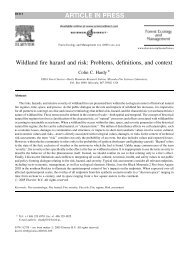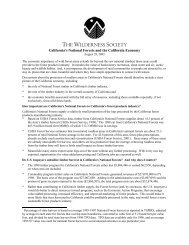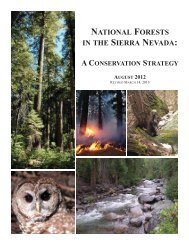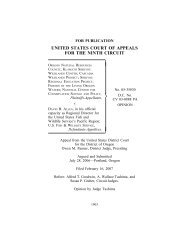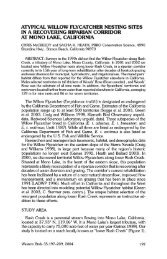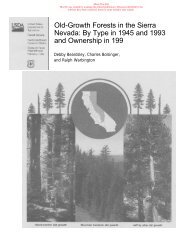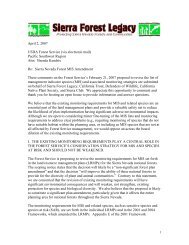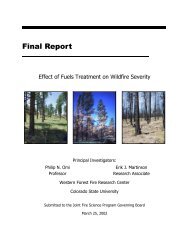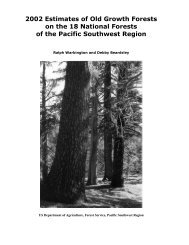Final report to - Sierra Forest Legacy
Final report to - Sierra Forest Legacy
Final report to - Sierra Forest Legacy
- No tags were found...
You also want an ePaper? Increase the reach of your titles
YUMPU automatically turns print PDFs into web optimized ePapers that Google loves.
1028VOLUME II, CHAPTER 36Hicks, T. 1995. Riparian moni<strong>to</strong>ring plan for hydropower projects.Bishop, CA: U.S. <strong>Forest</strong> Service, Inyo National <strong>Forest</strong>.Hill, M. T., W. S. Platts, and R. L. Beschta. 1991. Ecological andgeomorphological concepts for instream and out-of-channel flowrequirements. Rivers 2: 198–210.Holmes, D. O. 1979. Cultural influences on subalpine and alpinemeadow vegetation in Yosemite National Park. In First conferenceon scientific research in the national parks, edited by R. M. Linn, 1267–72. Washing<strong>to</strong>n, DC: National Park Service.Hughes, J. E. 1934. Erosion control progress <strong>report</strong>. Quincy, CA: U.S.<strong>Forest</strong> Service, Plumas National <strong>Forest</strong>, Milford Ranger District.Hupp, C. R. 1986. The headward extent of fluvial landforms andassociated vegetation on Massanutten Mountain, Virginia.Environmental Management 11: 545–55.Jennings, M. R. 1996. Status of amphibians. In <strong>Sierra</strong> Nevada EcosystemProject: <strong>Final</strong> <strong>report</strong> <strong>to</strong> Congress, vol. II, chap. 31. Davis: Universityof California, Centers for Water and Wildland Resources.Johnson, W. C. 1992. Dams and riparian forests: Case study from theupper Missouri River. Rivers 3: 229–42.———. 1994. Woodland expansion in the Platte River, Nebraska: Patternsand causes. Ecological Monographs 64 (1): 45–84.Jones and S<strong>to</strong>kes Associates. 1989. Downstream effects ofhydroelectric development on riparian vegetation: A joint PG&E/SCE research project. Sacramen<strong>to</strong>: Jones and S<strong>to</strong>kes Associates.Junk, W. J., P. B. Bayley, and R. E. Sparks. 1989. The flood pulse conceptin river-floodplain systems. In Proceedings, International Large RiversSymposium, edited by D. P. Dodge, 110–27. Ottawa: CanadianMinistries of Fisheries and Oceans.Katibah, E. F., K. J. Dummer, and N. E. Nedeff. 1984. Current conditionof riparian resources in the Central Valley of California. In Californiariparian systems: Ecology, conservation, and productive management,edited by R. E. Warner and K. M. Hendrix, 314–21. Berkeley andLos Angeles: University of California Press.Kattelmann, R. 1996. Hydrology and water resources. In <strong>Sierra</strong> NevadaEcosystem Project: <strong>Final</strong> <strong>report</strong> <strong>to</strong> Congress, vol. II, chap. 30. Davis:University of California, Centers for Water and WildlandResources.Kattelmann, R., and M. Embury. 1996. Riparian areas and wetlands.In <strong>Sierra</strong> Nevada Ecosystem Project: <strong>Final</strong> <strong>report</strong> <strong>to</strong> Congress, vol. III.Davis: University of California, Centers for Water and WildlandResources.Kauffman, J. B. 1988. The status of riparian habitats in PacificNorthwest forests. In Streamside management: Riparian wildlife andforestry interactions, edited by K. J. Raedeke, 45–55. Seattle:University of Washing<strong>to</strong>n, Institute of <strong>Forest</strong> Resources.Kinney, W. C. 1996. Conditions of rangelands before 1905. In <strong>Sierra</strong>Nevada Ecosystem Project: <strong>Final</strong> <strong>report</strong> <strong>to</strong> Congress, vol. II, chap. 3.Davis: University of California, Centers for Water and WildlandResources.Knight, A. W., and R. L. Bot<strong>to</strong>rff. 1984. The importance of riparianvegetation <strong>to</strong> stream ecosystems. In California riparian systems:Ecology, conservation, and productive management, edited by R. E.Warner and K. M. Hendrix, 160–67. Berkeley and Los Angeles:University of California Press.Kondolf, G. M. 1993. Lag in stream channel adjustment <strong>to</strong> lives<strong>to</strong>ckexclosure in the White Mountains of California. Res<strong>to</strong>ration Ecology1: 226–30.———. 1994a. Cumulative watershed effects in the Sequoia National<strong>Forest</strong>: Summary of oral testimony before the House AgricultureCommittee, 9 March 1994. Hearing before the Subcommittee onSpecialty Crops and Natural Resources on H.R. 2153, the Giant SequoiaPreservation Act of 1993. 103rd Congress, 2nd session, 9 March.House of Representatives Serial No. 103–58.———. 1994b. Geomorphic and environmental effects of instreamgravel mining. Landscape and Urban Planning 28: 225–43.———. 1994c. Lives<strong>to</strong>ck grazing and habitat for a threatened species:Land-use decisions under scientific uncertainty in the WhiteMountains of California. Environmental Management 18 (4): 501–9.Kondolf, G. M., and R. R. Curry. 1986. Channel erosion along theCarmel River, Monterey County, California. Earth Surface Processesand Landforms 11: 307–19.Kondolf, G. M., L. M. Maloney, and J. G. Williams. 1987a. Effect ofbank s<strong>to</strong>rage, and well pumping on base flow, Carmel River,California. Journal of Hydrology 91: 351–69.Kondolf, G. M., and W. V. G. Matthews. 1993. Management of coarsesediment on regulated rivers. Report 80. Davis: University ofCalifornia, Water Resources Center.Kondolf, G. M., and P. Vorster. 1993. Changing water balance overtime in Rush Creek, eastern California, 1860–1992. Water ResourcesBulletin 29: 823–32.Kondolf, G. M., J. W. Webb, M. J. Sale, and T. Felando. 1987b. Basichydrologic studies for assessing impacts of flow diversions onriparian vegetation: Examples from streams of the eastern <strong>Sierra</strong>Nevada, California. Environmental Management 11: 757–69.Kondolf, G. M., and P. R. Wilcock. In press. The flushing flow problem:Defining and evaluating objectives. Water Resources Research.Krzysik, A. J. 1990. Biodiversity in riparian communities andwatershed management. In Watershed planning and analysis inaction, edited by R. E. Riggins, E. B. Jones, R. Singh, and P. A.Rechard, 533–48. New York: American Society of Civil Engineers.Leigh<strong>to</strong>n, J. P., and R. J. Risser. 1989. A riparian vegetationecophysiological response model. In Proceedings of the Californiariparian system conference: Protection, management, and res<strong>to</strong>ration forthe 1990s, edited by D. L. Abell, 370–80. General Technical ReportPSW-110. Berkeley: U.S. <strong>Forest</strong> Service, Pacific Southwest <strong>Forest</strong>and Range Experiment Station.Lemons, J. 1979. Visi<strong>to</strong>r use impact in a subalpine meadow, YosemiteNational Park, California. In First conference on scientific research inthe national parks, edited by R. M. Linn, 1287–92. Washing<strong>to</strong>n, DC:National Park Service.Liddle, M. J. 1975. A selective review of the ecological effects of humantrampling on natural ecosystems. Biological Conservation 7:17–36.Ligon, F. K., W. E. Dietrich, and W. J. Trush. 1995. Downstreamecological effects of dams: A geomorphic perspective. BioScience45 (3): 183–92.Loredo, I., D. Van Vuren, and M. L. Morrison. In press. Habitat useand migration behavior of the California tiger salamander. Journalof Herpe<strong>to</strong>logy.Lyons, J. K., and R. L. Beschta. 1983. Land use, floods, and riverchannel changes: Upper Middle Fork Willamette River, Oregon(1936–1980). Water Resources Research 19 (2): 463–71.Madej, M. A., W. E. Weaver, and D. K. Hagans. 1994. Analysis of bankerosion on the Merced River, Yosemite Valley, Yosemite NationalPark, California, USA. Environmental Management 18 (2): 235–50.Mahoney, D. L., and D. C. Erman. 1984. The role of streamsidebufferstrips in the ecology of aquatic biota. In California ripariansystems: Ecology, conservation, and productive management, edited byR. E. Warner and K. M. Hendrix, 168–74. Berkeley and Los Angeles:University of California Press.



